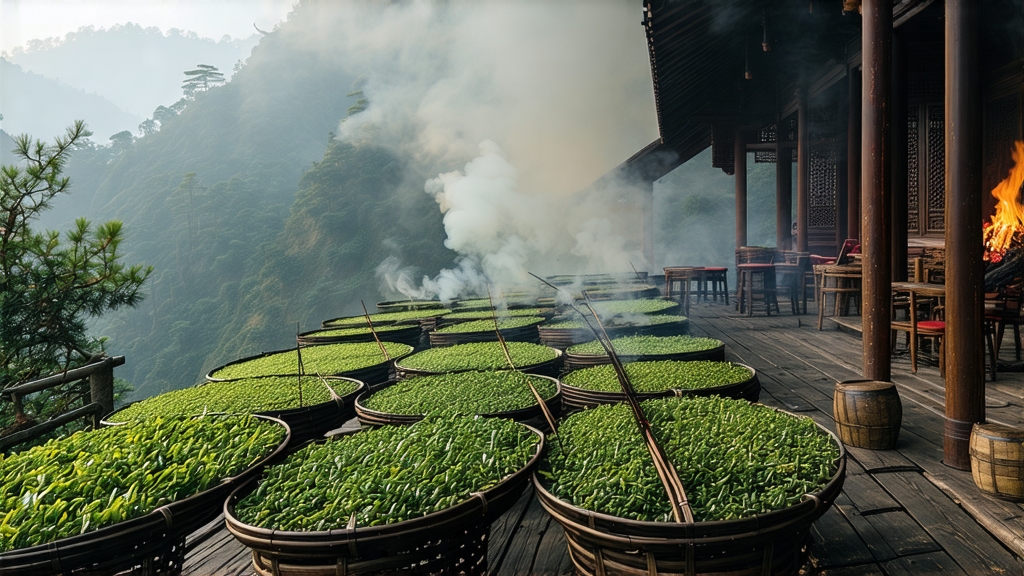
Lapsang Souchong—known in China as Zheng Shan Xiao Zhong—is the tea that started the black-tea revolution. When Dutch merchants brought the first crates of “bohea” to Europe in 1604, drinkers from Amsterdam to London were startled by the dark leaves, the amber liquor, and the unmistakable scent of a campfire curling from the cup. In the smoky taverns of the Thames, it was christened “Lapsang,” a romanization of the Fuzhou dialect for “pine village,” and “Souchong,” the grade of leaf picked after the traditional two-leaves-and-a-bud flushes had passed. Thus the name, like the tea itself, is a marriage of Chinese terroir and global imagination.
Geography and Terroir
Authentic Zheng Shan Xiao Zhong can only be produced inside the 600-square-kilometer core of the Wuyi Mountain World Heritage Site in northern Fujian. Here, a subtropical monsoon climate collides with mineral-rich, weathered igneous soil. Morning fog drifts off the Jiuqu (Nine-Bend) River, slowing photosynthesis and concentrating amino acids in the leaves. The indigenous cultivar—cai cha, a small-leaf, late-sprouting shrub—roots itself in crevices of weathered tuff, absorbing the same rock essence that gives Wuyi oolongs their “yan yun” or rock rhyme. The result is a leaf that carries both floral sweetness and the resinous memory of surrounding Masson pine forests.
Two Families, Two Smokes
Farmers divide Lapsang into two stylistic bloodlines. “Traditional style” (yan xun) is withered over towering pine-log fires, rolled, oxidized, then hot-smoked in bamboo baskets lined with fresh pine needles and rosin. The smoke bonds to the leaf’s moisture, polymerizing into guaiacol and syringol, the same phenols that lend Islay whiskies their peaty bite. “Unsmoked style” (wu xun), created for the modern domestic market, forgoes the final smoking; instead, withering is done with gentle charcoal heat, yielding a honeyed, longan-fruit liquor closer to a Keemun or Dian Hong. Both styles share the same plucking standard—one open leaf, no bud—picked in the brief window between Qingming and Grain Rain when spring nights are still cool enough to lock in fragrance.
Craft in Four Acts
- Withering: Leaves are spread on bamboo mats raised three meters above a ground fire of local Masson pine. The temperature is kept below 30 °C for eight hours, softening cell walls while infusing a light base smoke.
- Rolling: A 55-minute machine roll breaks 65 % of cells, releasing catechins and polyphenol oxidase. Craftsmen listen for the sound of “silk tearing,” an auditory cue that oxidation will proceed evenly.
- Oxidation: The leaf pile is covered with wet hemp cloth in a pine-paneled room kept at 24 °C and 80 % humidity. Four turns every thirty minutes ensure uniform browning; the process stops when the leaf edge turns chestnut and the center remains olive-green, a dual-color state called “tiger skin.”
- Smoking & Drying: Traditional batches are then loaded into bamboo baskets suspended over a slow pinewood fire for six to eight hours. The fire must never flame—only smolder—so the craftsman feeds it short, thumb-thick sticks every twenty minutes, using the interval to nap in a hammock slung between two camphor trees. The final moisture target is 3 %, low enough to travel by clipper ship around Cape Horn without molding.
Grading the Leaf
European importers once classified Lapsang into Pekoe, Orange Pekoe, and Souchong, but Wuyi farmers use a more tactile system. “Lapsang A” is picked below 600 m elevation, machine-rolled, and lightly smoked; it delivers brisk, tarry notes ideal for Russian samovars. “Lapsang AA” comes from 600–900 m gardens, is half-hand-rolled, and spends one night in pine smoke, giving a balanced whisky-and-raisin cup. The summit grade, “Zheng Shan Xiao Zhong Original,” is plucked from the 1200 m Wuyi core,